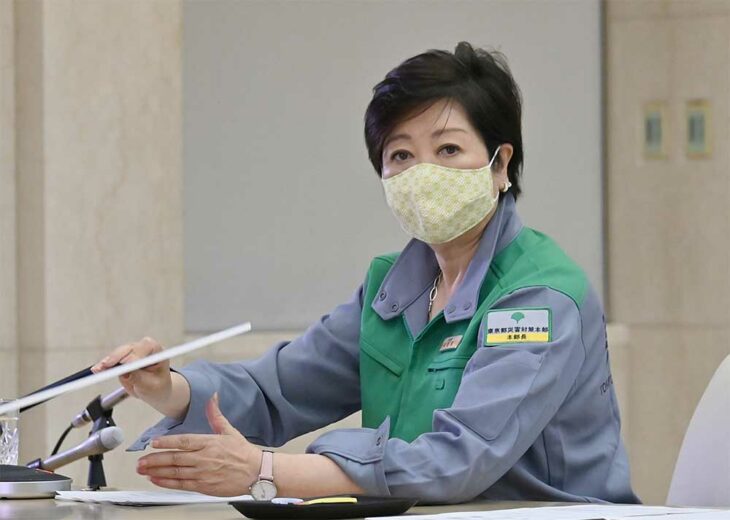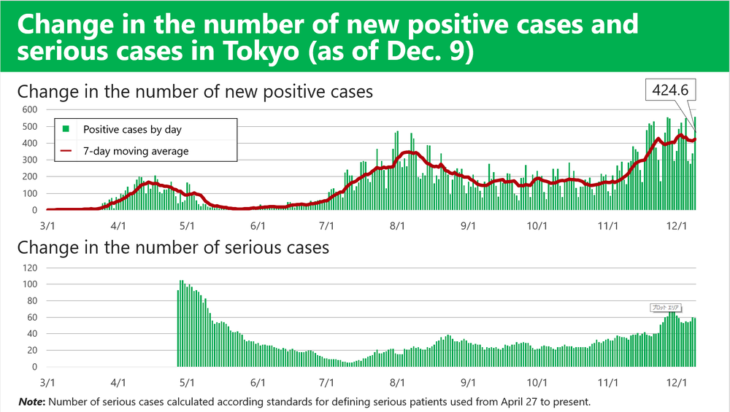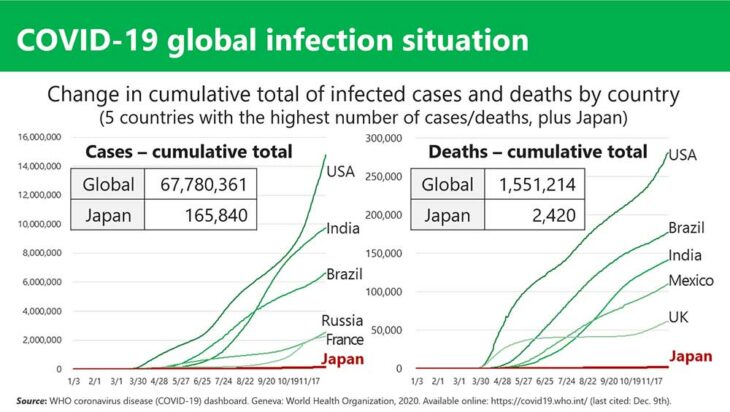Tokyo Metropolitan Government: Measures to combat COVID-19―The challenge of containing mass infection in a megacity with an aging population
Koike Yuriko, Governor of Tokyo
Public hygiene supports the Tokyo Megacity’s measures to combat COVID-19

Koike Yuriko
©Tokyo Metropolitan Government
2020 was originally supposed to be the year of the Tokyo Olympic and Paralympic Games. However, the COVID-19 pandemic compelled us to postpone the games. Currently, I am fighting this invisible enemy, as are the heads of local governments around the world. Tokyo, the capital of Japan, is a megacity with a population of approximately 14 million. The percentage of elderly people 65 or older in Tokyo is extremely high: 23.3%. Looking at Tokyo’s COVID-19 situation, there have been roughly 45,500 total infections and 530 deaths. As of December 10, 2020, there are approximately 60 people with severe infections in hospitals. As the number of infected people is increasing now, on November 19 the Tokyo Metropolitan Government (TMG) raised its coronavirus alert level of the infection situation to the highest level. Nevertheless, when compared to the world’s largest cities, Tokyo has been successful in containing COVID-19. Despite our being a large city, why has the number of infected people remained at this level? Why are the number of critically ill people and COVID-19 deaths so low, against this backdrop of an aging population? People from overseas often ask questions about this mystery.
I believe one factor is the extremely high use of face masks in Japan. The wearing of face masks has been a regular habit in Japan since the 1918 pandemic. In addition, I myself have repeatedly asked the citizens of Tokyo to wear masks since the beginnings of the pandemic. According to one survey, the utilization rate of face masks in Japan is currently 94%, almost three times higher than the 28% recorded last year. This is due to not only people’s desire to protect themselves, but also people’s thoughtfulness for others and their consideration to avoiding causing others difficulty—traits that are common among the Japanese people. We should be proud of these high moral values that are our heritage.
The high morals of the Japanese people can also be seen in the cases described below. In Japan, the Constitution makes it difficult to infringe upon private rights. From a legal perspective, measures to control COVID-19 that restrict people’s activities cannot be enacted, and fines and penalties cannot be imposed on violators. When the government of Japan declared a state of emergency in April, it was not possible to enact coercive lockdown measures and TMG had no option but to respond to the situation by requesting that Tokyo residents voluntarily refrain from going out. At one stage, employees of TMG visited downtown districts in Tokyo, persuading the citizens to refrain from going out. Even though, from a legal perspective, it was not possible to enact compulsory measures, Tokyo residents responded supportively to the request from TMG and behaved decently. In central Tokyo, daily crowd figures decreased to less than 30% of normal, which contributed to slowing the rapid spread of the COVID-19 coronavirus.
I believe that, despite being a large city, Tokyo has been comparatively successful in suppressing the pandemic because of the hard work of valuable healthcare professionals and also because the Japanese people have a high level of awareness of adherence to social norms and public hygiene. Moreover, looking back at the history of Japan and Tokyo suggests that the work of our predecessors, achieved through the effort and tradition established over time, has played a great role in building the foundations for the public sanitation systems and the current measures we are taking to protect the city from infectious diseases.
Exploring public hygiene from the beginning
Goto Shinpei, the 7th Mayor of Tokyo City about a century ago, is known for enabling Tokyo, the capital of Japan, to evolve into a modern city, developing it into a city that defends life from disaster in the aftermath of the 1923 Great Kanto Earthquake. Goto was also a doctor and his efforts to ensure public hygiene and protect life are another widely known accomplishment. Before becoming the Mayor, he was the chief of the Hygienic Bureau of the Ministry of Home Affairs and worked to establish the Institute for Infectious Diseases, Japan’s first private infectious disease institute. The institute was founded by Kitasato Shibasaburo, who later discovered pest bacilli, in Tokyo in 1892 and became the predecessor of the Institute of Medical Science, the University of Tokyo. It was also the base foundation for the Kitasato Institute.
In 1895 when Goto Shinpei was the administrative director of the Temporal Quarantine Department of the Imperial Army of Japan, he quickly constructed a large quarantine depot on Ninoshima Island in Hiroshima Prefecture. An unprecedentedly large quarantine was conducted for up to 230,000 soldiers returning home from China which was experiencing a cholera outbreak after the end of the Sino-Japanese War. Although his actions may have been severely criticized at the time, his bold initiatives and ability to execute them prevented the spread of cholera in Japan and saved the nation from that infectious disease.
Moreover, looking at the history of universal health coverage (UHC), the most characteristic feature of Japan’s healthcare insurance system, we can see Goto’s foresight and commitment to its establishment. Having studied in Germany, where the world’s first health insurance was created, Goto as the chief of the Hygienic Bureau of the Ministry of Home Affairs drafted the Workers’ Sickness Insurance Bill in 1898. This bill made the Japanese public aware of the mechanisms of health insurance systems. Although the bill was rejected and did not become law, Goto’s proposals became one of the sources for the enactment of the Health Insurance Act of 1922, the National Health Insurance Law of 1938, the National Health Insurance Act of 1958 as well as UHC in 1961.
The establishment of public health centers has contributed to the further development of public hygiene in Tokyo. Public health centers support public hygiene across Japan and play a central role in the current measures addressing COVID-19. Japan has adopted a strategy regarded as unique in the world, in which public health centers lead initiatives to identify clusters of patients and bust those clusters. As public health nurses and others at the public health centers have a deep understanding of local circumstances and also have abundant experience in tuberculosis investigations and contact tracing, they can play a key role in the daily COVID-19 case investigations and contact tracing.
The beginning of public health centers dates back to 1935 when Japan’s first health center was established in Tokyo. It became an early prototype for today’s public health centers. It was established using donation from the Rockefeller Foundation in the United States, and handled child hygiene and tuberculosis prevention, among other matters.
In 1937, public health centers were established as administrative bodies at 49 locations across the nation. In 1947, immediately after the end of the Second World War, the New Health Center Law was enacted under the guidance of the GHQ, and the functional capabilities of public health centers were expanded. The number of public health centers in Tokyo increased to 41 and they handled matters regarding permits and authorizations in the fields of food sanitation, environmental hygiene and medical and pharmaceutical affairs, and had the authority to police sanitation.
Currently, there are approximately 500 public health centers nationwide and 31 in Tokyo.

©Tokyo Metropolitan Government
Regarding measures addressing COVID-19, public health centers operate as contact points for Tokyo residents, answering questions, supporting responses to patients, following up on infection clusters as described above, and other actions. Since the beginning of the COVID-19 pandemic, the public health centers on the front lines of the COVID-19 measures have faced increasing volumes of work. The public health centers under the jurisdiction of TMG are only those in certain parts of the Tama district and the island districts, while those in the special wards of central Tokyo and the other parts of Tama district are outside the jurisdiction of TMG. We have dispatched approximately 120 employees to support the public health centers outside its jurisdiction.
Additionally, to prepare for a rapid increase of infections, the government has expanded its contact tracing teams and is working to strengthen its ability to support public health centers in the Tokyo area in general. From a broad perspective, TMG is committed to responding to the needs of all of Tokyo by providing needed information and making necessary adjustments for the public health centers in Tokyo.
The foundation of public hygiene in Japan and the Tokyo Megacity was established through the efforts of our predecessors. I hope to follow the example of Goto Shinpei and protect the lives of Tokyo’s citizens and the future of Tokyo as the current governor of Tokyo, through coordinated action and daring, strong policies.
Rainbow-colored COVID-19 safety stickers: New normal through meticulous measures
The public hygiene of Tokyo today is based on the foundations described above. Tokyo has been devising meticulous measures to combat COVID-19, including the expansion of testing systems and the securing of healthcare provision systems, with the goal of focusing on a new stage of co-existence with COVID-19, in which measures to prevent the spread of COVID-19 and socio-economic activity are compatible.
We have requested that restaurants, bars, theaters, museums, gyms and various other facilities display the rainbow-colored COVID-19 safety stickers to indicate that measures to prevent infections are being taken. As mentioned above, legally, it is not possible to forcefully restrict people’s activities in Japan. However, with the cooperation of business operators, the number of stickers posted has reached approximately 290,000. In April, the Tokyo Metropolitan Ordinance to Prevent the Spread of COVID-19 was enacted. In August, the ordinance was revised to make it a best-effort obligation to place the sticker, among other revisions. In October, the ordinance was revised again to specify the responsibilities of TMG and municipalities, the citizens of Tokyo and the business operators in order to improve the effectiveness of the measures.
Moreover, TMG is asking that COVID-19 patients with mild or no symptoms stay and recover at hotels to prevent the spread of infection, but some patients stated that they were unable to find anyone to care for their pets while they stay and recover at hotels. Accordingly, starting on October 9, we have established new accommodation facilities that permit patients to spend their recovery period with their pets, if they own dogs, cats, rabbits or hamsters.
In the lead up to winter, there is a risk of an influenza outbreak occurring simultaneously with the COVID-19 pandemic. We are strengthening initiatives to protect the elderly who are more susceptible to serious illness. These initiatives include making routine influenza vaccinations free for the elderly who are 65 or older. Moreover, COVID-19 infections have been increasing recently in facilities for the elderly. TMG has entered into an agreement with a certain organization whose members include many facilities for the elderly in Tokyo. Under the agreement, a broad-based support system will be established to enable the dispatching of support teams from other facilities to facilities where an outbreak of infection has occurred. This will allow facilities experiencing an outbreak to continue providing services to their residents.
Human bonding

COVID-19 Monitoring Report https://tokyodouga.jp/foreign/daily-eng
©Tokyo Metropolitan Government
The second and third waves of the COVID-19 pandemic are rampaging across the globe, particularly in Europe and the United States, and many large cities have imposed second lockdowns. I heard of the temporary closure of the theaters on Broadway and other theaters, restaurants and many other facilities. I was sad to hear that many people have died, lost their jobs and are suffering from COVID-19 around the world.
Looking back on history, human beings have overcome many challenges. I have no doubt that human beings will overcome this unprecedented crisis. Tokyo has been implementing meticulous measures, including the rainbow-colored COVID-19 safety stickers, and has started to take steps toward a “new normal” gradually.
The 1920 Olympic Games in Antwerp held shortly after the First World War and the 1918 pandemic were a symbol of post-crisis solidarity and recovery. The Olympic and Paralympic Games Tokyo 2020 that will be held in Tokyo next year will be extremely significant and symbolize that human beings, through unified effort, have defeated the invisible enemy of COVID-19, and will have further strengthened their bonds. In cooperation with the citizens of Tokyo, I will work to exhaustively prepare to welcome the visitors from all around the world.

Source: Tokyo Metropolitan Government COVID-19 Monitoring Report as of December 10 https://tokyodouga.jp/usraq6lipx8.html
Translated from an original article in Japanese written for Discuss Japan. [December 2020]
Keywords
- Koike Yuriko
- Governor of Tokyo
- Tokyo Metropolitan Government
- COVID-19
- aging population
- public hygiene
- 1918 pandemic
- social norms
- moral values
- face masks
- Goto Shinpei
- cholera
- universal health coverage
- public health centers
- Tokyo Olympic and Paralympic Games






